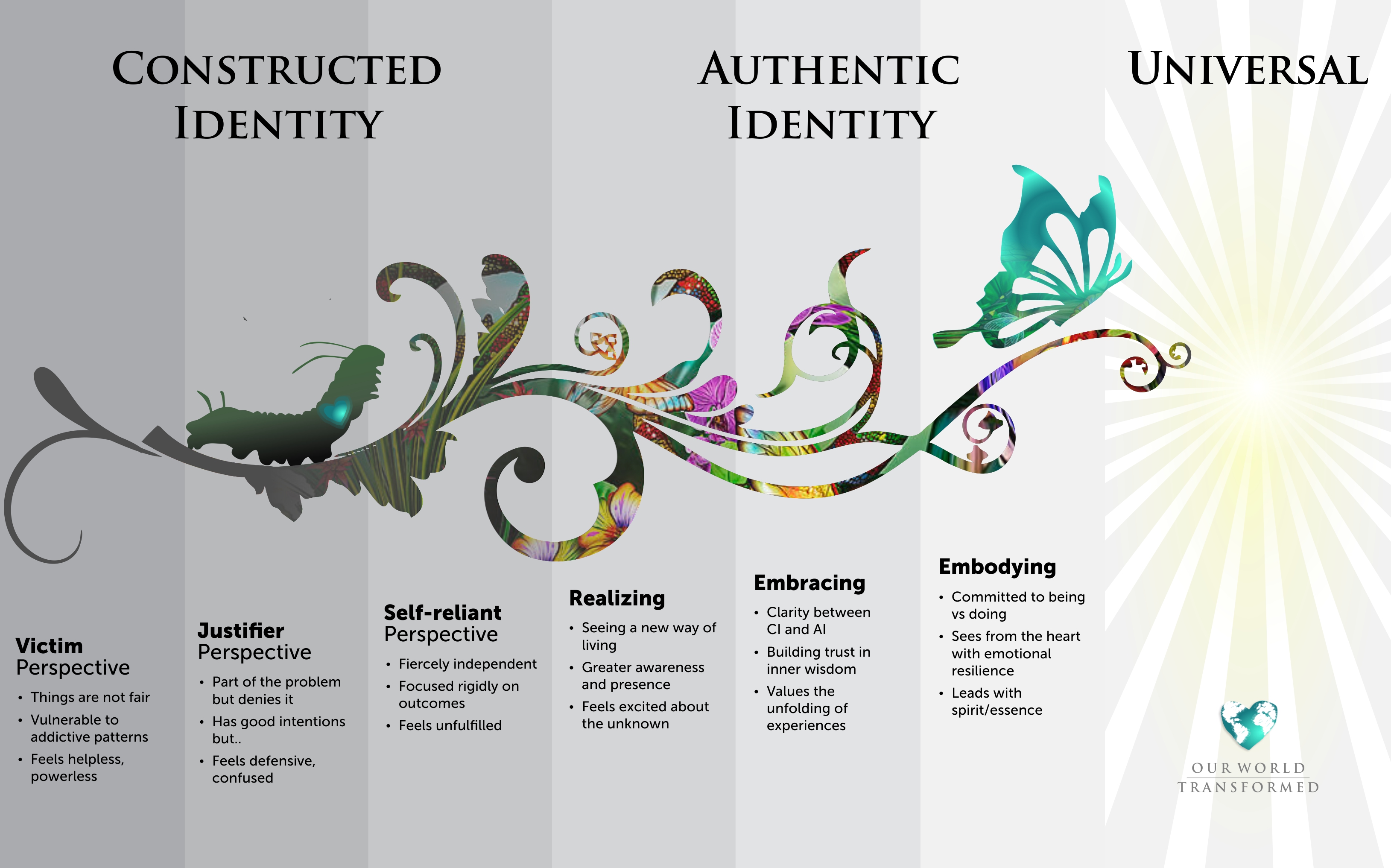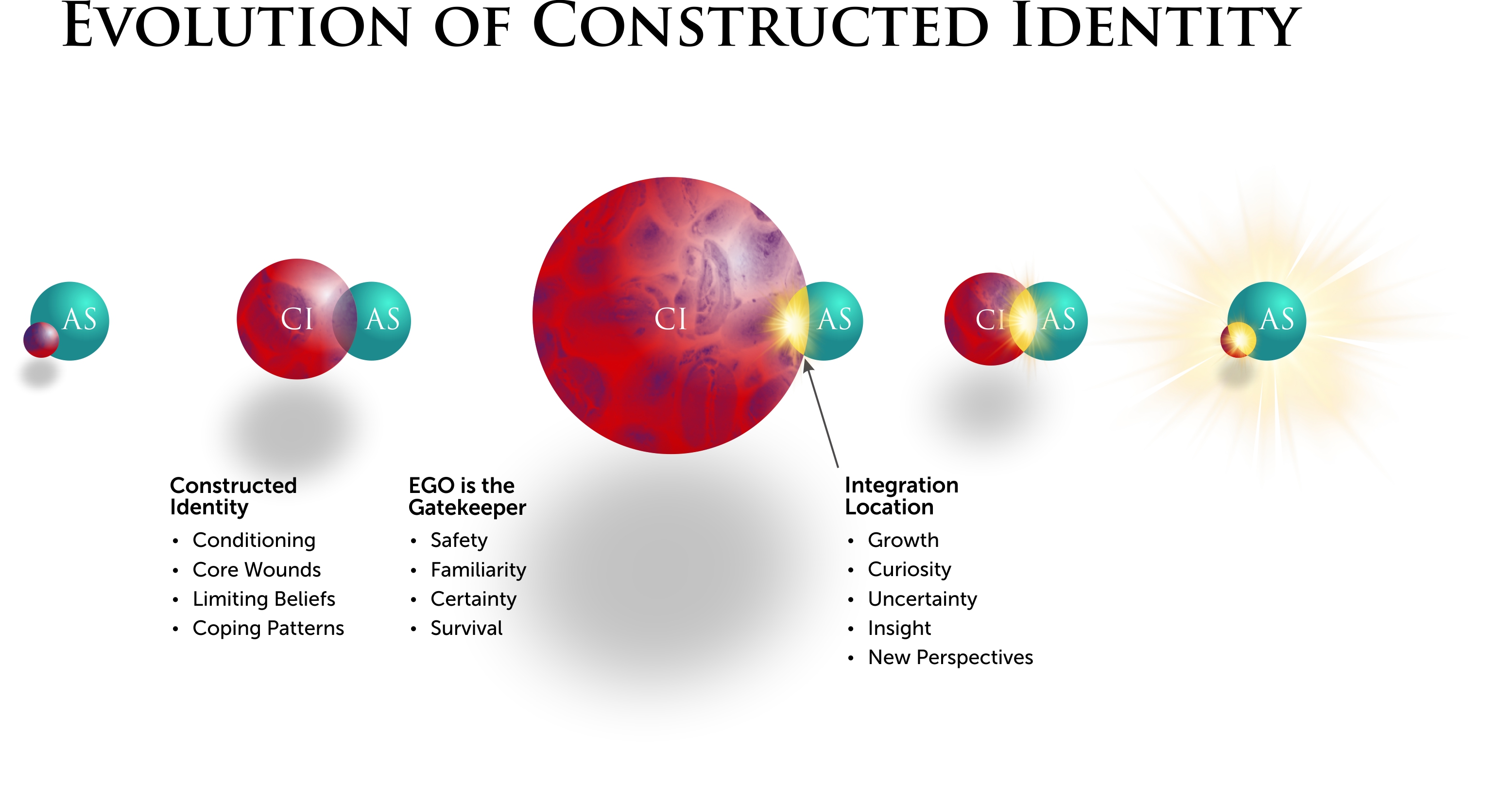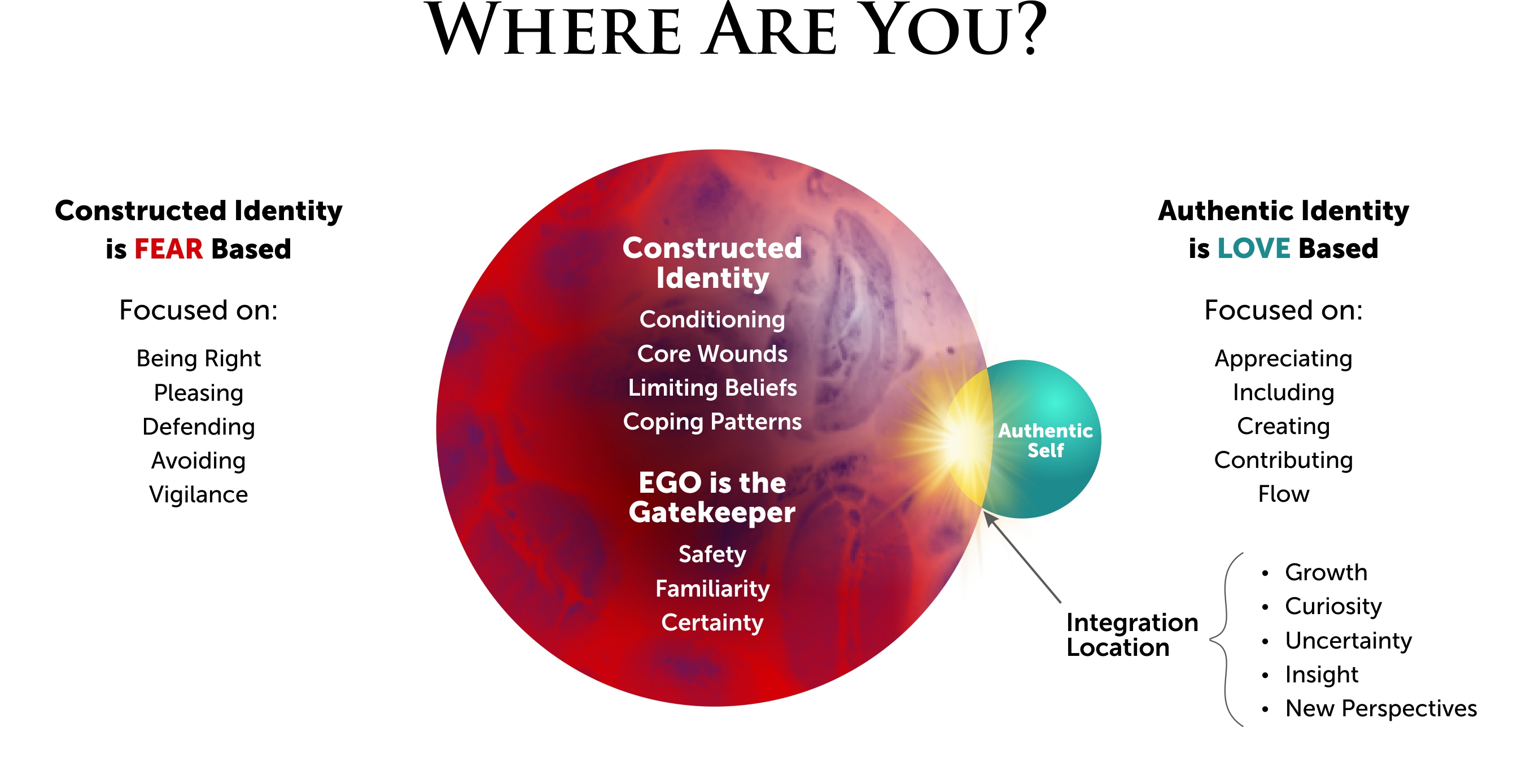In 1920, Sigmund Freud described the Ego as a mental construct that bridges the gap between our more primal and acculturated selves. Thousands of years before, Lao Tzu wrote that “knowing others is intelligence; knowing yourself is true wisdom” and “mastering yourself is true power.”
This wisdom informs modern-day thinking, as well, in concepts such as self-determination theory and Carol Dweck’s growth mindset, both of which suggest that having an innate sense of ability, control, and connection allows for greater motivation and action. So whether it is given the name of ego, self-concept, self-perception, or personality, people throughout history have seen that our definition or perception of “self” serves as a foundation for our interactions with the world.
How, then, does this foundation influence us? What kinds of thoughts, and actions, might emerge from our relationship with this foundation? For this, we have the Identity Continuum: a roadmap of the stages of selfhood. This includes all we’ve experienced and witnessed as necessary and natural steps on the path to fulfillment.

The Identity Continuum paints a picture of how we develop our concept of self, and shows how shifts in awareness, accountability, self-compassion, and healing can allow us to experience the world in a more authentic way. But, as with the lovely butterfly, we must always begin as a crawling caterpillar…
The First Shift: Awareness and Accountability
“Reactivity is enslavement. Responsibility is freedom.” Sadhguru
Even for us bipedal creatures, the feeling of crawling is one with which we are all familiar. Of course, we did crawl, at one point, but most of us have also had the feeling of not moving quickly enough – or in the right direction – even as adults. We feel “stuck” and tell ourselves “life is hard” and ask, “why does this keep happening to me” or “what am I supposed to do?”
These thoughts foreshadow the first significant shift of identity: from thinking life is unfair to taking personal responsibility for that life. It is a shift from an external focus to an internal one. This is the territory of a plethora of self-help books, gurus, and classes which teach that, in order to gain control over one’s life, one must be accountable and take responsibility. A Victim perspective might ask, “why did this happen to me,” then get caught in thinking life is unfair.
Slowly, we learn to seize influence over our circumstances, taking ownership of our thoughts, feelings, and actions. When the Justifier no longer rationalizes incongruence between their behaviours and values, they move toward self-reliance and ask “how am I responsible for this?” The underlying belief here is an empowered one; we discover we have great influence over our lives and thus place our focus on where we can leverage that influence for the results we actually want.
The caterpillar stage of our lives is the journey of the Constructed Identity. Becoming Self-reliant is a wonderful step in the journey towards fulfillment, and it can transform your world. But even after discovering the power of Self-reliance, and seeing the results we wanted, many of us end up feeling stuck once again. Why?
Constructed Identity: Life of a Caterpillar
“I am a part of all that I have met.” Alfred Tennyson
Getting stuck in the Self-reliant perspective is buried under the tangled idea of “results we want.” Oftentimes this is just what we think we want, taught to us since childhood by a myriad of people and experiences. We might learn to value family, sacrifice, and self-control. We may be taught to compete, to be ambitious, and express ourselves fully. We might be told that money, memories, connection, or status are the markers of success. While pursuing any number of those values might lead us to success, they are built from our upbringing, the conditions, experiences and people that surrounded us. The early conditioning will inevitably limit us living our full potential. This is perhaps captured succinctly in the concept of moving from “good to great.” Many successful people reach the level of “good” but struggle to reach greatness because, in order to achieve greatness, you must relinquish the familiar patterns that brought you to “good.” Many people get stuck in the Self-reliant stage because society highly values this stage! In fact, many of us grow up believing this stage is the goal, as living in Self-reliance can bring with it lots of financial and social rewards.

When immersed in Constructed Identity, our actions are guided either towards living in safety, comfort, and certainty or the opposite: living in excitement, thrills, and freedom. We fill our lives with what we think will meet our needs and allow us to survive. These are powerful forces coded into our psychology and even our biology; it is no wonder we spend so much time and energy feeding into them, and why, at first, they seem to be the results we want. But then, for most people, there comes a time when dissatisfaction starts to creep in; perhaps even after achieving much of what we thought we wanted. We start to become aware of an inner self that wants something more, a greater degree of alignment or fulfillment.
The caterpillar is much the same, in fact: put bluntly, it is an eating machine. Its job is to consume and consume, growing and molting several times until it has all the nutrients it needs to become a pupa. What is important to recognize about this stage of life, then, is that all the time we spend as a caterpillar is valuable and necessary. When we move from Constructed to Authentic Identity, we transcend and integrate – not cast away – the Constructed Self. Those nutrients we gained through working towards a promotion, being polite to in-laws, and trying to get skinny are all required for the caterpillar to be ready for transformation and comprise the wings of our future.
The Second Shift: Self-compassion and Healing
“To become what one is, one must not have the faintest idea what one is.” Friedrich Nietzsche
The commitment to pursue transformation is a real challenge. While pursuing this transformation, we might find that the version of ourselves we have constructed for our jobs or in our relationships is not our core self. Consider the conditions of entering into a chrysalis: after long years of roaming, hiding, and eating, we have to curl up, hang in place, and pray that the other bugs and birds don’t gobble us up while we transform into something seemingly unrecognizable. Where becoming Self-reliant meant owning our results, taking responsibility, and being in control, the journey into authenticity is one of relinquishment. The focus shifts from “doing” to “being.” But what are we relinquishing, and what is this state of “being?”
Consider again the type of thoughts that characterize Constructed Identity. The Victim perspective might struggle with confidence and say, “I’m shy, people just don’t listen to me.” The Self-reliant person believes instead “I can make myself heard and choose to be confident.” Both of these are stuck in “doing.” At first, we focus externally on the actions of others – such as on whether or not they are listening. An internal shift gives us power to speak our truth, but each mindset is still limited to behavior. The idea of “being confident” is still trapped behind the conditions of acting in a certain way and gaining approval from others. This thinking is not fully representative of our inner selves and we limit joy and self-compassion in favor of actions and outcomes. The authentic person’s mindset, instead, is in a state of “being” and has no prescribed behavior.
These are the discoveries that invite us into the Realizing stage of the Authentic Self. In the Realizing stage of Authentic Identity the person is exploring what it feels like to live from this foundation. The person asks, “Am I feeling safe within myself? Am I feeling open-hearted and accepting?” They will question “Is impressing others the most important thing to me? Is that what I truly want?” This perspective is one that explores the underlying beliefs of the Constructed Self and seeks out the aspects of our identity that we often tend to hide, repress or deny.
Relinquishing our constructed beliefs is what allows us to simply “be;” it allows us to soak in the world around us without expectation or criticism. To better understand this state, recall a moment where you felt profoundly at peace. For many of us, it happens in nature – sitting by the ocean, perhaps, listening to the waves and watching the sun drift inexorably across the sky as our evening ends and another’s morning begins. Attention fades into undirected presence, absorbed in the sensations of the now. There is no question of safety, or sufficiency. The ease and joy experienced in these moments is spontaneous and unconditioned; it is as natural as the movement of the sun. The Realizing stage begins when we recognize that this state is always a possibility, and the Embracing stage begins when we invite this state into our lives continuously.
The pathway to ease, however, is not always easy. It is not just the setting sun and sparkly ocean that unfolds in front of us – it’s setting the table and stinky laundry, as well. Allowing presence to wash over us even in these moments is the practice of Embracing. This can be guided by the core belief that every moment, everything, and every experience has value. When feeling those old sensations of threat, the Embracing person pauses. They allow the fear to pass through them and fill the path behind it with appreciation, treasuring the richness of the experience and inviting themselves to feel viscerally the value of the moment they are in.

It is important to remember that we do not integrate the constructed and the authentic through judgment or anger, nor are we motivated to change through fear or avoidance. We call this stage Embracing because it is guided by love; we heal the scars where the Constructed Self split off from the authentic one by having compassion for both, and we act through a desire to create experiences in service to our whole, healed self.
The Third Shift: Presence
“When I let go of what I am, I become what I might be.” Lao-Tzu
Embodying is the final stage of the Authentic Identity, where integration of the Constructed Self and the presence that comes with it becomes normalized, comfortable, and even honored. In much the same way that accountability becomes the default for the Self-reliant person, radical acceptance becomes the default for the Embodying one. In this space, the Self is balanced and accepted in its entirety.
From here, the practice that remains is one of presence, openness and expansion. As a natural product of seeing and accepting ourselves, we learn to see and accept others as a reflection of the same journey. The initial differentiation between internal and external breaks down as our selfhood gradually becomes limitless in its definition. Where before we recognized we are the culmination of all that we have experienced, we may now begin to identify with daily experience itself and the limitless opportunities for joy and happiness it contains.
Throughout this process, at all stages, we will move unevenly in different fields of our lives. Like the branches we climb, we do not grow in straight lines. It is also important to remember that, to the caterpillar, the way of life of a butterfly is utterly foreign. The butterfly moves about in a way that is radically different, and simply not possible, to the little bug still clinging to branches. But this is by design – the steps taken to eat, molt, pupate, and break free collectively allow flight to be possible. Unlike us, the caterpillar does not become angry at itself for not having wings today; it simply trusts that, when the time and place is right, the wings will come. So trust the process, keep gathering and putting knowledge into action for new experiences, and keep integrating those experiences as you return to wholeness. Your wings will come, too.
“One day, in retrospect, the years of struggle will strike you as the most beautiful.” Sigmund Freud